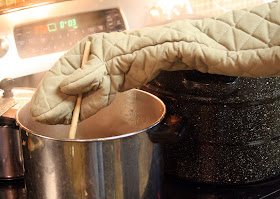 |
| Slice of apple pie |
The key to a good apple pie is the apples and the crust. I like Johnathan apples or Jonagold for my pies or a mix of apples. More importantly I always try to find locally grown apples, and I am willing to change my apple choice for what is fresh (or frozen from my freezer). I cannot stand mushy apples in my pie. Yuck! So I steer clear of apples that get mushy when they cook. How do I know which ones to get? Well, I talk with the local farmers and discuss with them this year's harvest and what they suggest. They have never lead me astray. I am hoping to have my own apples next year (and peaches and blueberries); my adventures in gardening and landscaping could be a whole another blog (unfortunately it would be a comedy).
The Crust
I believe that the more you make crust, the better your crust will be. You will begin to understand how the dough should feel and look and it will become second nature (but you will have missteps as I did below. Missteps are not the end of the world. Your pie will still (most likely) taste good, it just might not be as pretty). I love crust- I love eating raw dough, the scraps of dough baked with a little cinnamon and sugar, and of course the crust on a pie. I think I might like the crust more than the filling. My favorite is a crust made with lard but I don't use lard anymore. I am amazed that a couple of ingredients can be transformed into something so delightful.
3 Cups (375 g) of Unbleached Flour
1 Tsp of Salt
3/4 Cup (143 g) of Shortening
6 to 9 Tbsp of Ice Water
1 Egg, Beaten with 1 Tsp of Water (to seal the bottom of the crust and to brush the top of the crust- not needed until you roll the crust out)
Fill a small glass with water and ice. Place the glass of water and a tablespoon next to your workspace.
Combine flour and salt in a large bowl. Add the shortening with either a pastry blender (cut the shortening into the flour), two knives (cut the shortening into the flour), or your fingers (I use my fingers to rub the shortening into the flour).
 |
| Ready to cut in the shortening |
 |
| Ball of dough. I should have added a bit more water. |
Note **** Before rolling out the dough, you should have your filling done and ready to go. Also at this point preheat your oven to 450F/232C/Gas Mark 8.
Place the dough on a lightly floured wood surface and roll out from the center of the dough. In a pinch, I have used a floured glass before to roll out my dough but it is a lot easier to use a lightly floured rolling pin.
Place the bottom crust into the pan and gently press it into space. If you want pretty edges, trim the edges so they are even but leave enough to make a pretty edge. Brush the bottom of the crust with a beaten egg with a little bit of water.
 |
| My dough was a little dry and I had to patch the dough on the bottom crust |
 |
| Ready for the top crust |
Finally, brush the top of the crust with the egg water mixture and sprinkle with cinnamon sugar. Cut a couple of vents into the pie so the hot air can escape.
Bake for 10 minutes at 450F/232C/Gas Mark 8 and then lower to 350F/176C/Gas Mark 4 and bake for an additional 40 minutes. The pie should be golden brown. If your pie crust is getting too brown, cover the edges with foil.
Filling
Please modify this recipe based on the sweetness/tartness of your apples. I like to add the sugar and the spices a bit at a time and taste the filling to get it just right.
1 Tbsp of Lemon Juice
1 Tsp of Brandy (Optional)
1 Tbsp of Unbleached Flour
1 Tsp of Cinnamon
1/4 Tsp of Nutmeg or Allspice
1/4 Cup to 1/2 Cup (50 g to 100g) of White Sugar
1/4 Cup to 1/2 Cup (55g to 109g) of Light Brown Sugar, Packed
2 Tbsp of Butter (To put on top of filling)
Cinnamon Sugar (To sprinkle on the top of the pie)
Combine the apples with the lemon juice and the brandy. Add half of the spices and sugar and all of the flour.
 |
| Apple pie filling |
 |
| Freshly baked apple pie |










































